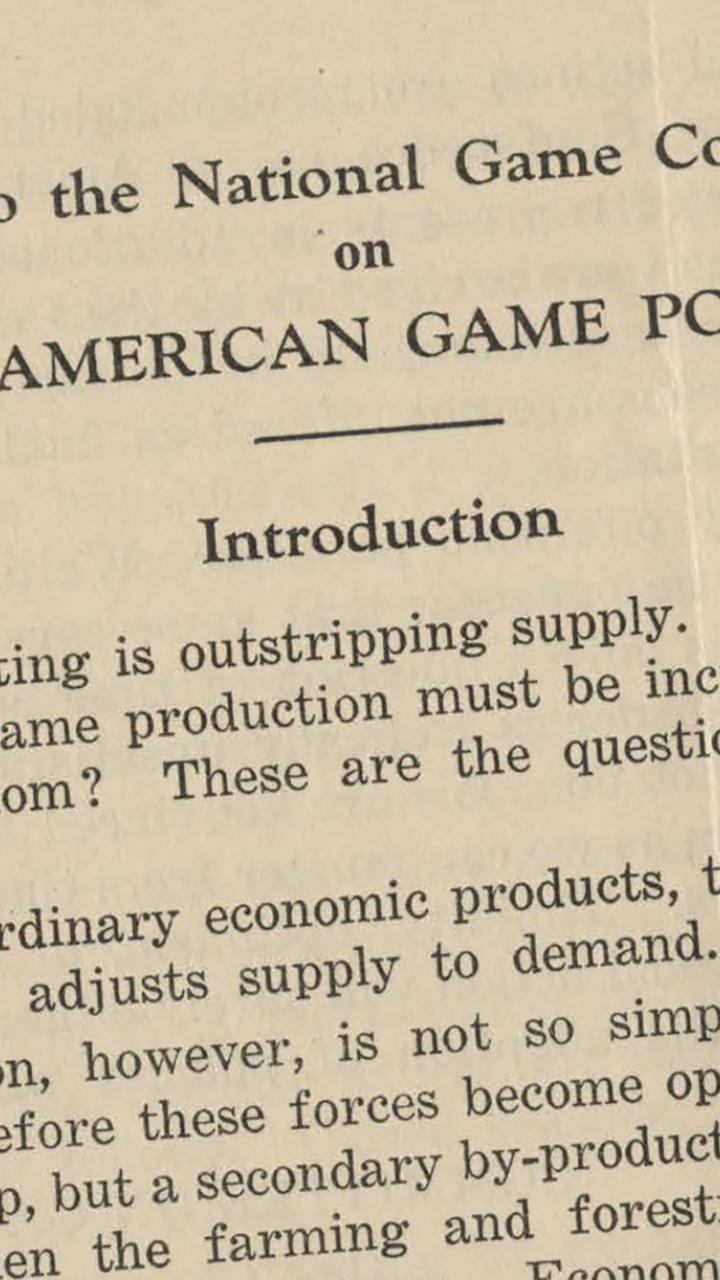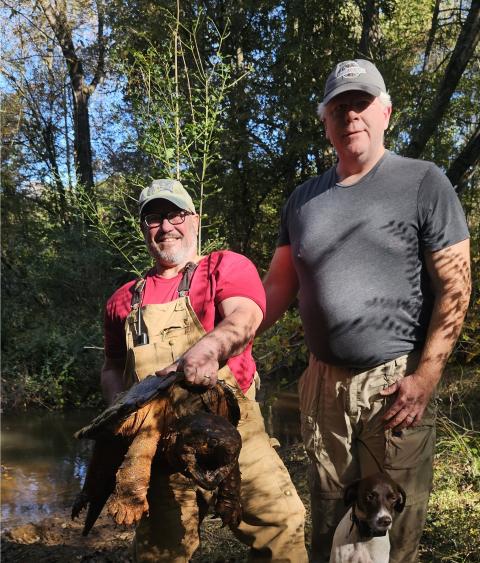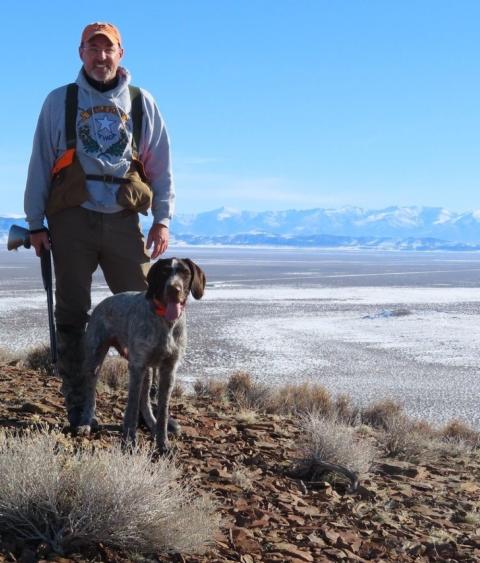Breadcrumb
- Home
- Outdoor News Bulletin
- July 2025
- Foundations of Conservation: North American Wildlife Policy of 1973
Outdoor News Bulletin
Foundations of Conservation: North American Wildlife Policy of 1973
Adapted from Lane Kisonak’s remarks during the Special Session “The Foundation of Conservation is Cracked – Now What?” at the 90th North American Wildlife and Natural Resources Conference in March 2025
Let me start with a quick update on a little fish many of us may know: Percina tanasi, better known as the snail darter.
Early in the new year I came across an article in the New York Times that added a new wrinkle to the story. What else is there to tell, you might wonder, nearly 50 years after the snail darter made history as the subject of a landmark decision from the U.S. Supreme Court? Let’s try the money quote, from fish biologist Thomas Near, summing up his team’s new study: “There is, technically, no snail darter."1
To those of us who learned about the snail darter and the Tellico Dam as akin to the ESA what the Boston Tea Party was to the American Revolution, this looks like a busted myth. But I’d argue Dr. Near’s biggest claim is that the snail darter—genetically, his team suggests, a population of the stargazing darter—was a “species [people decided] should be distinct because it will have a downstream conservation implication.”2 A species created not by natural selection but through motivated reasoning.
The TVA v. Hill decision, made in 1978, affirmed that the Endangered Species Act requires federal agencies to ensure their actions do not jeopardize the existence of an endangered species like the snail darter, or destroy or modify its habitat. Said the Court: “This language admits of no exception.”3 These six words turned the ESA into “the third rail of environmental politics that it remains today."4
Putting aside that the Tellico Dam was built, and the snail darter was delisted, we see that history never rests. Look at the online comments to the story; what you’ll see is litigation of dams in general, the inadequacies of politics, the contested legacy of the environmental movement.
But this is not the Internet—this is real life.
The Rise of the Environmental Decade
So, let’s stop for a moment along the path we’ve traced so far. Let’s remember—or try to imagine—the experience of a wildlife professional working five decades ago. As we know, 1973 was the year of the ESA. The 1970s were the Environmental Decade. From this era we got the ESA, NEPA, Clean Water Act, FLPMA—a list we know by heart. But we also remember it as a time of deep social fragmentation; loss of trust in public institutions; the height of the Vietnam War; economic distress.
The boom times of the post-War era had peaked, and the growing middle class was enjoying the fruits of high industrial productivity. More time outdoors, of course. But the seeds of our day’s disconnection from wildlife were already planted. Not just urbanization, but also expanding suburban development, which encroached more and more on habitats over time. And soon the healthy labor market went from unemployment of 3.5-4% in the early-to-mid-‘60s up to 9% by the mid-‘70s. We’re all familiar, too, with “stagflation”—price increases rose from 2-3% per year in the late ‘60s to monthly rates approaching 12% by 1974. A lot of this was rising fuel prices, but the general pressure on cost of living eventually produced a new bipartisan mood less favorable to new commemorations like Earth Day or new funding initiatives, and more demanding of new wells in the ground.
Many have compared the social attitudes and prevailing conditions of the 2020s to the 1970s, and for good reason. Echoes relevant to us include inflation as well as higher operational costs for wildlife and habitat management. Inherent in the spirit of that time as well, were new tensions with a nascent shift from utilitarian views of wildlife among the public to more mutualistic views.
Allen's Conservation Challenge
Shortly before the ESA was signed, this Conference put its mark on the field with a remarkable report. Billed as a successor to the American Game Policy of 1930, the 1973 North American Wildlife Policy Report came from a committee chaired by Durward Allen, once a researcher with Michigan DNR and eventually a professor at Purdue. The 1973 Report aimed to provide a “reexamination of principles and programs affecting our wildlife resources” and “supplement and update” the 1930 Policy.5
Before I reviewed the 1973 Report, I found myself looking further back in Professor Allen’s career to see how our Joshua to Aldo Leopold’s Moses saw conservation before all the upheaval of the late ‘60s and early ‘70s, in the underexamined window after P-R, D-J, the Lacey Act and MBTA, and before so much else.
In 1954 Allen published a book called Our Wildlife Legacy—a vividly-painted, deeply-considered, and at times humorous portrait of wildlife management as a profession coming into its own, flexing new muscles, testing the limits of its knowledge and its potential.
Allen spoke about ideals at their zenith—about our individual rights as well as “community rights and responsibilities…intimately tied up with the privilege of living in an America that we call The Beautiful.”6 He wrote with clear living memories of milestones like P-R and D-J, and you can understand why his writing is full of can-do spirit. His confidence extended to the idea that “a body of knowledge becomes a science when its facts are a reliable basis for predicting the future”7 and that wildlife conservation was approaching such maturity. He believed the time was ripe for “a national study of resource problems, a national plan, and effective national zoning” according to the best use of specific types of land.8 But he was well aware of the tension between these perceived needs and the reality that “Americans don’t like control. That’s how they got here in the first place."9
Of course that’s partly where the ‘60s and the social upheaval of those times came from. Sure, on one hand we got the environmental movement, but on the other hand got a new strain of young, rebellious individualism that culminated in what the author Tom Wolfe called “The Me Decade.”
Allen grappled with this anti-authority streak as a source of authority himself. “The greatest threat to public enlightenment,” he observed, “is the scholar, enamored of long words and abstractions, who writes to please himself…If…wisdom comes slow to the people, and if they harbor untoward suspicion of the man of science…it might be possible for one with sympathy and understanding to…make out a case for them.”10
This suspicion of authority is inseparable from the American experience. It also tends to be wary of what many of us in the legal field call “settled questions” and people who are dissatisfied with the answers, in some cases, will dig up the roots.
Allen shares an anecdote of a hearing in the early ‘50s in which a Federal judge suggests he might decline to enforce a prohibition against shooting waterfowl over bait because “it did not have the support of ‘the people.’” A like-minded lawyer picks up the shovel and asks “who these dictator-minded federal bureaucrats were to tell ‘the people’ how they should or should not hunt ducks.” Allen had little time for this sort of business. He saw firmly that “the ultimate and studied will of the whole public had its rightful expression in the creation of…agenc[ies] and…system[s] [by representatives of the people] for…gathering technical data…and…using this information to formulate and administer regulations[.]”11
Allen’s concern was to see that these agencies and systems function well, and to nurture their capacity to diagnose and respond to new and emerging ecological problems.
The Wildlife Policy Report
Two decades later, here at the North American, we received our diagnosis. Professor Allen, as chair of a committee with members from the U.S., Canada, and Mexico, presented the 1973 Report by first calling to “preserve and improve the wildlife resource” by “meeting the habitat requirements of all species, adopting necessary regulations, and providing for enforcement."12
The Report celebrated successes like the professionalization of wildlife management and increasing engagement by civic society. But it was well aware of our deepening “estrangement” from wildlife and “earth knowledge” and other issues “on which [they] ha[d] hardly made a constructive start.”13 It called for a “universal ecology” as a step up from the measures of Allen’s era, which he regarded dimly as “holding action[s].”14 As ever, Allen was clear that wildlife priorities “will need public acceptance as a competing value in our uses of land and water” and “require high priority in political and economic decisions."15
The Report reflected the nature of civic engagement with wildlife at the time by devoting some space to urban wildlife, and to the increasing prominence of bird watchers and nature photographers.16 Allen wondered, however, whether ceaseless urbanization would “deprive[]” people of wildlife-based recreation or whether “the complexity of [future] people’s lives [might] cause a turning to outdoor pursuits[.]”17 Decades of diminishing hunting, punctuated by our great exodus outdoors that started five years ago this week, show there is indeed much more to our relationship with the outdoors than where we live and work.
The Report also grappled with the limitations of our funding sources, noting that excise-taxed goods and license revenue go nowhere near far enough for non-game species. Ultimately, his day’s trend of more and more special taxes and appropriations filling the void18 stalled out sooner than his team might have expected, even as the many pressures on imperiled species grew and grew.
The Report reflected the nature of civic engagement with wildlife at the time by devoting some space to urban wildlife, and to the increasing prominence of bird watchers and nature photographers.
Another stressor Allen knew well: “fragmented jurisdictions.” The 1973 Report urged State and Federal agencies to “be less preoccupied with guarding their spheres…and more attentive to opportunities for cooperation[,]”19 a challenge I think we in this room do our best to face directly, but one that seems to elude our full grasp in some new way every year.
Allen renewed his 1954 call for “[a] national zoning of [land] uses” in tandem with retention of public lands.20 This would be complemented by cooperative, incentive-based efforts on private lands—especially farmlands—in partnership with agricultural agencies and with the goal of fostering public access for hunting opportunities.21 Over the past few years, of course, we’ve seen a number of new cooperative frameworks with farmers and forest owners, as well as efforts to expand recreational shooting areas as the Report calls for22, and more. And let’s not forget the American Conservation and Stewardship Atlas, part of this decade’s America the Beautiful initiative, designed to gather up national metrics for land and water conservation. (About this last item, time will tell.)
We could spend hours on all the pieces of this Report, cataloguing what our field still prioritizes and where it’s changed direction. That’s because the committee’s vision of wildlife policy was expansive. Water and wetland pollution, for example, are identified as “the greatest limiting factor to the health of aquatic life” with “incalculable” impact on fisheries and recreation.23 Of wetlands, the 1973 Report noted that 40 million acres had been lost up to that point, mostly during the 20th century.24 A detailed series of wetlands policy steps followed.25 For invasive species, the Report urged “rigid federal and state control."26
Moving Forward from the Report
For all its foresight, some of the Report’s predictions are notable in how they’ve faltered. Take predator management: Allen and his colleagues take it as a given that “predator control policies…are undergoing changes that will make them more acceptable to a public that has become keenly conscious of predator values.”27 Take human population: Yes, our numbers increased by half over half a century. But now there is, by many accounts, a worldwide fertility crisis. Take the declaration that “[the] right to exist [of other forms of life] should be an acknowledged ethic.”28 Universal ecology, rights of nature—these are not the lingua franca of our time, when our system of self-government faces fresh tests each day of the very basics.
While the trust-based ethic, the regulatory strategies, and the scientific progress underlying the North American Model and the professionalization of wildlife management through the post-War era mitigated grave and impending ecological losses, generational wins like P-R and D-J made it appear deceptively easy to Allen’s committee to extend our record at the steady clip they were accustomed to.
To be sure, Allen knew that maintaining our conservation infrastructure was never a foregone conclusion. He extolled the virtues of the Cooperative Research Unit program in his 1954 book, celebrating the way these units could “erase the lines of cleavage and give all agencies…a common front[.]” And he was forthright about the burdens on our institutions to make so little money go so far:
When blanket cuts and reductions are made, the skin-tight budgets and limited staffs that represent [conservation] functions shrink still more, and that leaves the way a little more open to those whose thinking has an ever-current date line and to whom ‘production’ has become a fetish and an end rather than a considered means.29
And he cared for the next generation of wildlife professionals, hoping that they would someday benefit from greater stability in the system. “To be perpetually breaking in new trainees,” he wrote, “only to lose them when they become most valuable, has been a source of inefficiency and discouragement to the directors of conservation programs.30
Complexity is at the root of everything we do. It means mistakes are inevitable.
By the time Allen started working on the 1973 Report, he was writing in part for this next generation. A cohort that came up in the ‘60s and ‘70s, bearing witness to political assassinations, the war in Vietnam, and soon Watergate, people just starting their careers would have been primed to hear calls to cynicism. Maybe a few of them read Joan Didion, who wrote: “I have trouble maintaining the basic notion that keeping promises matters in a world where everything I was taught seems beside the point. The point itself is increasingly obscure."31
But they bought no part of that message. Instead, they devoted their lives to all of this. Many of them may have found inspiration in the frank listing of tasks facing our field in the 1973 Report, and by the spate of action by Congress, by States, and from all corners of civil society. There was an undeniable energy. There was determination.
And there was care: As Aldo Leopold wrote in a posthumously-published essay “The Round River,” “To keep every cog and wheel is the first precaution of intelligent tinkering.”32 Leopold also observed that “[t]he outstanding scientific discovery of the twentieth century is not television, or radio, but rather the complexity of the land organism.”33 Complexity is at the root of everything we do. It means mistakes are inevitable. Perhaps, after all that conflict, whose repercussions we still face today, the darter truly is stargazing. But complexity, whether it emerges from new knowledge, or the interlocking of individual parts, or the creation of interdependent relationships, or systemic reliance on answers to questions of “settled law,” means systems are much harder to build and sustain than to deconstruct.
History never rests. But I’d like to leave you all with a thought: Just as Allen’s concern was to see our agencies and systems function well, this must now be our concern. The sociopolitical environment of the 2020s has clearly marked this as a singular challenge. As we face a broad and growing distrust of systems, of complexity, of interdependence in our relationships—we have no choice but to meet this challenge and communicate our intent clearly if we want to succeed at anything else.
- Jason Nark, This Tiny Fish’s Mistaken Identity Halted a Dam’s Construction, N.Y. Times (Jan. 3, 2025), available at https://www.nytimes.com/2025/01/03/science/snail-darter-fish-tellico-dam.html.
- Id.
- Tennessee Valley Authority v. Hill, 437 U.S. 153, 173 (1978).
- Baier, Lowell E., The Codex of the Endangered Species Act, Vol. I: The First Fifty Years. Rowman & Littlefield, 2023, at 102.
- Allen, Durward L., Wildlife Management Institute, Report of the Committee on North American Wildlife Policy 73 (1973) (hereinafter “1973 Report”).
- Allen, Durward L. Our Wildlife Legacy. Rev. ed. Funk & Wagnalls, 1962, at v (hereinafter Our Wildlife Legacy).
- Id. at 279.
- Id. at 335.
- Id. at 338.
- Id. at 281.
- Id. at 294.
- 1973 Report at 73.
- Id. at 74.
- Id. at 73-74.
- Id. at 74.
- Id. at 75.
- Id. at 75-76.
- Id. at 76.
- Id. at 78, 90.
- Id. at 78.
- Id. at 80, 87.
- Id. at 87.
- Id. at 82.
- Id. at 83.
- Id.
- Id. at 88.
- Id. at 89.
- Id. at 75.
- Our Wildlife Legacy at 285-88, 303-04.
- Id. at 287-88.
- Didion, Joan. “In the Islands,” The White Album. Noonday, 1979, at 133.
- Leopold, Aldo. A Sand County Almanac with essays on conservation from Round River. Sierra Club/Ballantine, 1966, at 190.
- Id.





